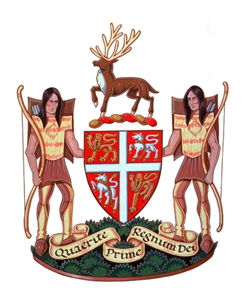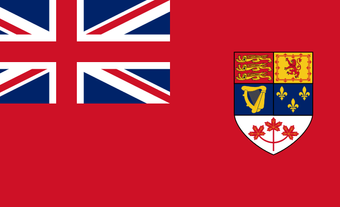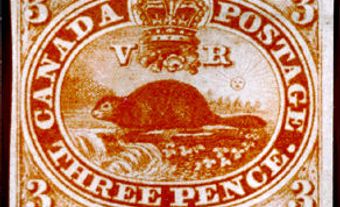Each Canadian province and territory has been granted or has adopted emblems that represent sovereignty and identity. These emblems are coats of arms, flags, provincial floral emblems, animals, plants, minerals and, in some cases, tartans. Through symbolism, they express the features of a province or territory, and its inhabitants: history, geography, natural resources, flora and fauna, human activities, values and aspirations. While the description of a coat of arms in the specialized language of heraldry never changes, stylistic execution and proportions can vary. This allows governments to give their coat of arms a different look from time to time, provided the basic elements remain the same.
Alberta
Coat of Arms

Arms granted by King Edward VII 1907; crest, supporters and motto by Queen Elizabeth II 1980; Canadian Heraldic Authority registration 2008.
Symbolism
Arms - The arms of Alberta reflect its agriculture and geography: wheat fields, grass prairies, foothills, green hills and snow-capped mountains against a blue sky. In the top part, the red cross on white represents St. George, patron saint of England, and the arms of the Hudson’s Bay Company which originally governed the territory from which the province was carved.
Crest - The beaver refers to the fur trade as the first major economy in the region. The crown represents the sovereign whose royal duties in Alberta are exercised by the lieutenant governor of the province.
Supporters - The lion is a royal symbol and the pronghorn antelope is native to Alberta. The wild rose is the official flower of the province.
Motto - Fortis et liber is Latin for “Strong and free.”
Flag

Royal ultramarine field with provincial arms; adopted by provincial legislature 1968; Canadian Heraldic Authority registration 2008.
British Columbia
Coat of Arms

Arms and motto granted by King Edward VII 1906; crest, supporters and base by Queen Elizabeth II 1987; Canadian Heraldic Authority registration 1990.
Symbolism
Arms - The blue and white wavy bars symbolize the sea bordering the west shore of the province. The half sun indicates that it is the most westerly province of Canada where the sun sets. The Union Flag (Jack) in the upper section creates a link with England and the small crown in centre denotes that British Columbia was once a crown colony.
Crest - The crowned lion on the royal crown is the crest of the royal arms of the United Kingdom. The crest is made unique by a garland of Pacific dogwood, the provincial flower, around the lion’s neck.
Supporters - The wapiti stag and the bighorn sheep represent the colonies of Vancouver Island and British Columbia, and together, the union of the two colonies in 1866. They stand on a base of Pacific dogwood.
Motto - Splendor sine occasu, Latin for “Splendour without diminishment,” refers to the sun on the shield which never ceases to shine although it is setting.
Flag

Authorized by royal warrant 1906; confirmed by provincial order-in-council 1960; Canadian Heraldic Authority registration 1990.
Manitoba
Coat of Arms

Arms granted by King Edward VII 1905; crest, motto and supporters Governor General Ramon Hnatyshyn 1992; proclaimed by province and registered by Canadian Heraldic Authority 1992.
Symbolism
Arms - The design is based on the 1870 great seal of Manitoba. The buffalo represents Aboriginal peoples, such as the Assiniboine and the Cree, who derived both food and clothing from this animal. In the top part, the red cross on white refers to St. George, patron saint of England, and to the arms of the Hudson’s Bay Company which originally governed the territory from which the province was carved.
Crest - The beaver represents the riches of Manitoba’s natural environment and the fur trade, the province’s first major economy. The Royal Crown on the beaver’s back symbolizes constitutional monarchy, and the prairie crocus in its paw is the province’s floral emblem.
Supporters - The unicorn represents the province’s early Scottish settlers. Its collar — a crown made of stone blocks called a mural crown — symbolizes Manitoba’s position as Canada’s “keystone” province in the centre of the country. Its collar further alludes to the stones of Fort Garry, a Hudson’s Bay Company fort. The maple leaves symbolize Canada. The Red River cart wheel represents an early form of transport. The horse was vital to First Nations peoples and Métis, as well as European settlers. Its collar of Prairie Indian beadwork and the cycle of life medallion represent Aboriginal peoples. The water at the base represents the rivers and lakes as well as the origins of the province’s name, derived from the name of the Cree spirit Manitou. The grain field reflects the agricultural south; the forest, the north. The prairie crocuses are the provincial flower.
Motto - Gloriosus et liber, Latin for “Glorious and free,” derives from “O Canada” and evokes the democratic inheritance of Manitobans.
Flag

Red Ensign with provincial arms authorized by province 1966.
New Brunswick
Coat of Arms

Arms granted by Queen Victoria 1868; crest, supporters, base and motto Queen Elizabeth II 1984; Canadian Heraldic Authority registration 1989.
Symbolism
Arms - The water and ship refer to the shipping industry. The lion derives from the arms of England.
Crest - The salmon, a provincial resource, leaps from a coronet of mapleleaves representing Canada and supports the crown symbolizing a constitutional monarchy.
Supporters - The white-tailed deer is native to the province. Each deer is collared with a belt of Maliseet wampum (beadwork) honouring the Maliseet people. The pendant shields of France and England hanging from their collars refer to the dual origins of the province. Purple violets, the provincial floral emblem, grow at the base, along with ostrich ferns (fiddleheads), which are well known in the province.
Motto - Spem reduxit is Latin for “Hope was restored.”
Flag

Authorized by royal warrant 1868; by provincial proclamation 1963.
Newfoundland and Labrador
Coat of Arms

Granted by King Charles I 1637.
Symbolism
Arms - The colours of the flag of St. George, traditionally a red cross on white, are reversed to mark an alliance while making the arms distinctive. The lions and unicorns come from the royal arms of England.
Crest - In the grant from King Charles I, the crest is described as an elk although the horns as drawn are not right for that animal. Since elks never inhabited Newfoundland, many believe the native caribou was intended.
Supporters - Two Beothuk people, representing the original inhabitants, are dressed to go to war, equipped with bow and arrows and wearing armour made of wooden sticks.
Motto - Quaerite prime regnum dei is Latin for “Seek ye first the Kingdom of God” from the Gospel of St. Mathew.
Flag

The flag, designed by Christopher Pratt, was adopted by the provincial legislature in 1980. It is teeming with symbolism beginning with the colours: blue (sea), white (snow, ice) red (courageous struggle) and gold (confidence of the people in themselves and their future). The four blue triangles are a tribute to the Union Jack and British heritage. The red triangles represent the island and the Labrador mainland. The gold arrow points to a brighter future and honours military sacrifice. The arrow and two red triangles together form a trident (symbol of sea deities) representing the resources of the sea.
Northwest Territories
Coat of Arms

Authorized by Queen Elizabeth II 1956.
Symbolism
Arms - The wavy line follows the treeline dividing the tundra of the north (red) and the forests of the south (green). The arctic fox head represents the fur trade and the gold rectangles, mineral wealth. The white jagged upper portion represents the Arctic ice-cap. The wavy blue line refers to the Northwest Passage and honours the RCMP ship St. Roch, the first vessel to sail the Passage from west to east in the 1940s.
Crest - It displays the compass rose which refers to navigation and the magnetic pole. The narwhals, or sea unicorns, are guardians of the Canadian North.
Flag

Adopted by territorial council 1969. The white square (called “Canadian pale” in heraldry) displays the arms.
Nova Scotia
Coat of Arms

Coat of arms known to exist in 1625; reinstated by King George V 1929, replacing arms granted by Queen Victoria 1868; Canadian Heraldic Authority registration 2007.
Symbolism
Arms - The royal arms of Scotland in the centre is a version of their national flag (traditionally there is a white cross on a blue flag, here the colours are reversed) symbolizing that Nova Scotia began as a colony of Scotland.
Crest - The two hands, one in a gauntlet, together with the laurel and thistle, represent the peoples of Scotland and Nova Scotia (New Scotland) coming together peacefully as protectors and builders of the province.
Supporters - The unicorn wearing the crown of Scotland reflects the support of the King of Scotland for his colony, legally part of Scotland. The Aboriginal person wears a feathered headdress and kilt typical in 17th century heraldry. Both stand on a base where the provincial flower, the mayflower, is entwined with the thistle.
Motto - Munit haec et altera vincit is Latin for “This one defends and the other conquers.” “This one” refers to Scotland; “the other” to Nova Scotia.
Flag

Authorized by royal warrant 1929; Canadian Heraldic Authority registration 2007.
Nunavut
Coat of Arms

Granted by Governor General Roméo LeBlanc and registered by Canadian Heraldic Authority 1999.
Symbolism
Arms - The colours blue and gold reflect the riches of the land, the sea and sky; the Inuksuk symbolizes the stone monuments which guide travel on land and mark both sacred and special places; the qulliq, or Inuit stone lamp, represents light and the warmth of family and community; the five gold circles signify the life-giving properties of the sun; and the North Star (Niqirtsuituq) is the traditional guide for navigation and symbolizes the leadership of elders.
Crest - The Igloo represents traditional life and a means of survival. It also symbolizes the legislative assembly working for the advancement of Nunavut. The royal crown signifies public government and equal status with other Canadian provinces and territories.
Supporters - The tuktu (caribou) and qilalugaq tugaalik (narwhal) refer to the land and sea animals that are part of Nunavut's natural heritage and livelihood. They stand on a base composed of land and sea, and featuring three species of Arctic wild flowers.
Motto - Nunavut Sanginivut is Inuktitut for "Nunavut, our strength.”
Flag

Granted with the coat of arms; contains the colours (blue and gold), the inuksuk and the North Star, all found on the coat of arms. Red is a colour of Canada.
Ontario
Coat of Arms

Arms granted by Queen Victoria 1868; crest, supporters and motto by King Edward VII 1909.
Symbolism
Arms - The maple has been an important emblem of the province since the early 19th century. The cross of St. George denotes English heritage.
Crest - The black bear is widespread throughout the province. The crest does not have a helmet to rest on. It was omitted in the original drawing accompanying the grant, probably by mistake.
Supporters - The moose and the white-tailed deer are provincial animals.
Motto - Ut incepit fidelis sic permanent, Latin for “Loyal it began, loyal it remains” refers to the Loyalist origins of the province.
Flag

The Red Ensign with provincial arms approved by provincial legislature 1965.
Prince Edward Island
Coat of Arms

Arms and motto granted by King Edward VII 1905; crest and supporters by Governor General Adrienne Clarkson 2002, registered by Canadian Heraldic Authority and proclaimed by province 2002.
Symbolism
Arms - They are based on the first provincial seal used from 1769 until 1815, which also contained the motto. The oaks allude to the motto, the large oak representing Great Britain and the three saplings the colony. The three saplings may also refer to the three provincial counties which existed when the first seal was assigned. The lion comes from the royal arms of England, and can also allude to Prince Edward, Duke of Kent, for whom the province was named.
Crest - The blue jay is an official emblem of the Island. The red oak leaf in its beak refers to Prince Edward Island's official tree. The royal crown on the bird’s head indicates the province’s co-sovereign status within Confederation.
Supporters - The silver foxes emphasize the importance of the ranched fur industry. The collar of potato blossoms represents the Island’s main agricultural produce, and the fishnet collar alludes to fishing. The foxes stand on a grassy mound with flowers and the Mi’kmaq eight-pointed star. This star honors the Mi’kmaq as the first inhabitants and relates to the sun, a central symbol of their spirituality. It also highlights their craftsmanship, as it is depicted with woven porcupine quills. The rose, lily, shamrock and thistle symbolize the English, French, Irish and Scottish settlers. The lady’s slipper is the provincial floral emblem.
Motto - Parva sub ingenti (from the 1769 seal) is Latin for “The small under the protection of the great” taken from Book II of Virgil’s Georgics.
Flag

Authorized by royal warrant 1905; red and white border added by province 1964.
Québec
Coat of Arms

Authorized by a provincial order-in-council 1939, replacing the arms granted by Queen Victoria 1868, which had two blue fleurs-de-lis on gold.
Symbolism
Arms - The three gold fleurs-de-lis on blue appeared on the royal arms of France. The lion is from the arms of England. The maple was an important emblem of the province since the early 19th century.
Crown - The royal crown symbolizes a constitutional monarchy.
Motto - Je me souviens, French for “I remember,” was added by the architect Étienne-Eugène Taché in 1883. It is an invitation to Quebecers to remember their heritage and history.
Flag

Adopted by the provincial legislature in 1948. The white cross on blue was a flag of the French merchant marine at the time of New France. Four fleurs-de-lis were added.
Saskatchewan
Coat of Arms

Arms granted by King Edward VII 1906; crest, supporters and motto by Queen Elizabeth II 1986; registration Canadian Heraldic Authority 1995.
Symbolism
Arms - The lion is a royal symbol and wheat is the main agricultural produce. Yellow is for wheat, green for forests and grass, and red for prairie fires and the western red lily, the provincial floral emblem.
Crest - The royal crown symbolizes the sovereign and Saskatchewan’s status within Confederation. The beaver refers to the Canadian north, the fur trade and the province’s Aboriginal peoples. It holds the western red lily in its paw.
Supporters - The lion is another reference to the sovereign. The white-tailed deer is a provincial emblem. Their collars of Prairie Indian beadwork honour Aboriginal inhabitants and their star-shaped pendants take the shape of Saskatchewan’s Order of Merit, created in 1985 to recognize excellence and outstanding achievement in the province. The maple leaf on the lion’s pendant represents Canada. The western lily adorns the deer’s pendant and forms a wreath decorating the motto scroll.
Motto - Multis e gentibus vires, Latin for “From many peoples, strength,” reflects the ethnic diversity of Saskatchewan’s population.
Flag

Officially dedicated 1969. The green refers to the northern forests, the yellow to the grain fields. The flag also features the provincial arms and flower.
Yukon
Coat of Arms

Authorized by Queen Elizabeth II 1956.
Symbolism
Arms - The wavy white and blue vertical stripe is emblematic of the Yukon River after which the territory was named. The two red pyramidal forms displaying golden discs represent gold producing mountains and refer to the Klondike gold rush. The designer, Alan Beddoe, humorously expressed this idea as “Thar’s gold in them thar hills.” The cross of St. George in the upper part has in its centre a roundel with a blue and white pattern representing a heraldic fur (vair). It refers to the fact that the area was first discovered by fur traders working for the Hudson’s Bay Company.
Crest - The husky stands on a mound of snow. This sled dog was, for many years, an efficient way of ensuring transportation in winter and in places difficult to access.
Flag

Adopted by Council of the Yukon Territory 1967. Below the Yukon arms is a wreath of fireweed, floral emblem of the Yukon.

 Share on Facebook
Share on Facebook Share on X
Share on X Share by Email
Share by Email Share on Google Classroom
Share on Google Classroom


